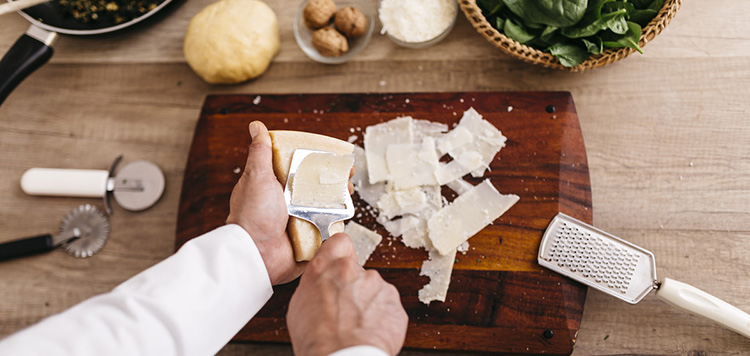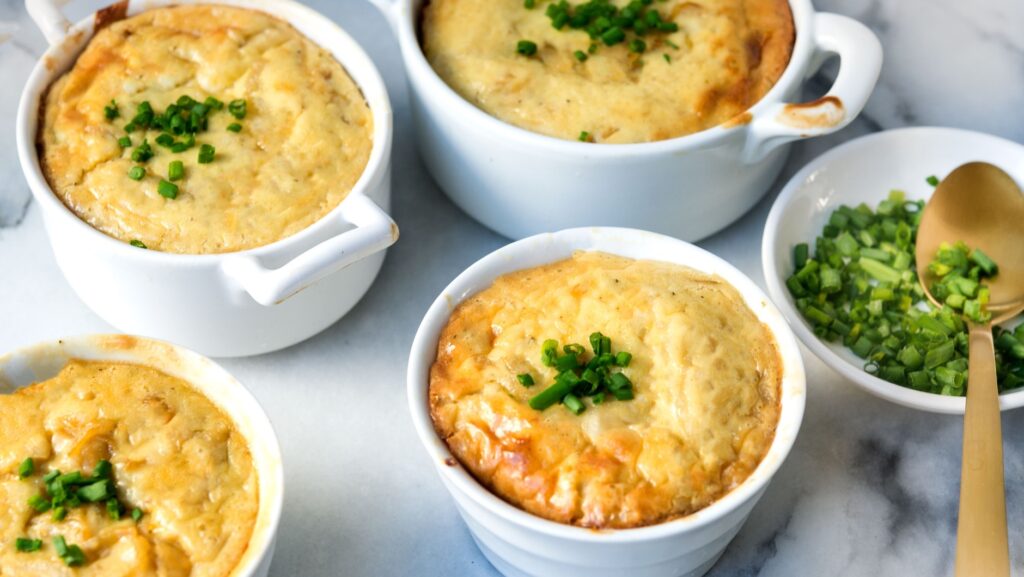You don’t have to go to culinary school to make a gourmet meal. Simply learning the definitions of the less familiar cooking terms that appear in recipes can make you more confident in the kitchen.
Many of the techniques described in cooking jargon are actually much easier than you’d expect. Don’t let fancy words deter you from creating a delicious meal — check out our glossary of culinary terms.
1. Al dente – firm to the bite. Al dente literally translates to “to the tooth” from Italian and is used to describe pasta and vegetables that are neither too crunchy nor too soft.
2. Au Gratin – covered with breadcrumbs and/or cheese and baked or broiled until golden brown. Traditionally, a shallow baking dish is used.
3. Bard – to tie fat around lean meats to prevent them from drying out during the cooking process. Fat should be removed a few minutes before the meat is done to allow browning.
4. Baste – to spoon, brush, or squirt a liquid, like meat drippings, stock, or butter, on food while it cooks. This adds flavor and prevents the food from drying out.
5. Blanch – to briefly submerge in boiling water, usually to partially cook a food. Oftentimes, blanched foods are immediately placed into a bowl of ice water to “shock” them, which stops the cooking process.
6. Bouquet Garni or Sachet – a bundle of herbs tied together or placed together in a cheesecloth used for flavoring stew, broth, or soup. Common herbs include parsley, rosemary, bay leaves, and thyme.
7. Braise – to brown or sear in butter and/or oil and then cook on low heat in a covered pot in cooking liquid for a long period of time. This process tenderizes the food and creates a full-flavored taste.
8. Brine – a solution of salt and water. Brining meat or poultry helps make the cooked meat moister.
9. Butterfly – to cut meat through the middle without completely separating the halves and then spread the halves to resemble a butterfly. This technique makes stuffing easier and allows meat to cook more quickly and evenly.
10. Coddle – to heat food (usually eggs) in water kept just below the boiling point. The process usually takes longer than boiling or poaching, but produces a more tender result.
11. Cream – to mix butter and sugar(s) together until well-blended for baking. They should form a fluffy, light, and creamy substance.
12. Cut In – to work solid shortening, lard, or butter into dry ingredients until they form small particles. You can use two knives, a pastry blender, food processor, or your fingers.
13. Deglaze – to dissolve the remains of roasted or sautéed food on a pan with a liquid such as wine or vinegar in order to create a sauce or gravy.
14. Emulsify – to mix liquids together that normally won’t bond together, like oil and vinegar. Ingredients like egg yolk and mustard help keep emulsions stable.
15. Flambé – adding high-proof liquor, like rum, cognac, or brandy, to a hot pan to create a burst of flames. The raw flavor of alcohol is burned off, leaving a sweet, subtle taste behind.
16. Julienne – to cut food into short, thin strips. You can use a knife, julienne peeler, or mandoline slicer.
17. Leaven – to add gasses to dough or batter so it rises and lightens during mixture or baking. You can use items with leavening agents, like yeast, beer, and kefir when baking bread.
18. Macerate – to steep a food (usually fruit) in liquid and/or sugar to infuse flavor and soften the food. The process is similar to marinating.
19. Mull – to infuse a beverage (usually wine, beer, or cider) with flavor by heating it with herbs, spices, and fruits. Common mulling ingredients include citrus juices, nutmeg, sugar, anise, and marjoram.
20. Pipe – to decorate or create shapes on food using thin lines of cream, paste, or icing. This process is often used in dessert and pastry baking.
21. Reconstitute – to restore a dehydrated food by placing it in water or some other liquid. The soaking process brings the food back to a resemblance of its original size, shape, and texture.
22. Render – to cook the fat out of meat using a low heat. Strain any solid chunks from the fat before you store.
23. Roux – a mixture of flour and fat, like butter, lard, or vegetable oil, cooked over low heat to thicken soups and sauces.
24. Score – to make shallow cuts into the surface of foods with a blade or sharp knife. This process is used in bread baking to control the direction in which the bread expands, as well as cooking meat and fish to aid in marinade absorption and tenderizing.
25. Truss – to tie up the wings and legs of poultry to prevent movement during cooking. You can use string, skewers, or pins to truss.




